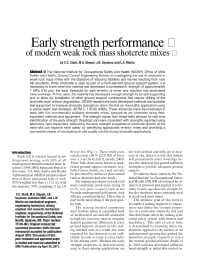Mining Publication: Early Strength Performance of Modern Weak Rock Mass Shotcrete Mixes
Original creation date: January 2011
Authors: CC Clark, MA Stepan, LA Martin
The National Institute for Occupational Safety and Health (NIOSH), Office of Mine Safety and Health, Ground Control Engineering Branch is investigating the use of shotcrete in weak rock mass mines with the objective of reducing fatalities and injuries resulting from rock fall accidents. When shotcrete is used as part of a multi-element ground support system, it is necessary to know when the material has developed a compressive strength of approximately 1 MPa (145 psi), the early threshold for safe re-entry of miner and machine into shotcreted mine workings. At this value, the material has developed enough strength to be self-supporting and to allow for installation of other ground support components that require drilling of the shotcrete layer without degradation. NIOSH researchers have developed methods and portable test equipment to measure shotcrete strength on site in the first six hours after application using a partial beam test standard, ASTM C 116-90 (1990). These advances were demonstrated in tests with five commercially available shotcrete mixes, sprayed as dry shotcrete using field- expedient methods and equipment. The strength values from these tests allowed for real-time identification of the early strength threshold and were consistent with strengths reported using laboratory-type equipment. Measuring the early strength properties of shotcrete directly at the mine site can improve mine safety by identifying appropriate re-entry times and providing a convenient means of conducting on site quality control during shotcrete applications.

- 60 Years of Rockbursting in the Coeur D'Alene District of Northern Idaho, USA: Lessons Learned and Remaining Issues
- Comparison of Ground Conditions and Ground Control Practices in the United States and Australia
- Determination of In Situ Deformation Modulus for Cemented Rockfill
- Developments in Sealant Support Systems for Ground Control
- Diagnosing and Controlling Moisture-Sensitive Roof in Coal Mines
- Dynamic Failure in Deep Coal: Recent Trends and a Path Forward
- The Long-term Performance of Surface Support Liners for Ground Control in an Underground Limestone Mine
- Numerical Model Calibration for Simulating Coal Pillars, Gob and Overburden Response
- Rock Falls
- Shotcrete Design and Installation Compliance Testing: Early Strength, Load Capacity,Toughness, Adhesion Strength, and Applied Quality
- Technology News 542 - Field Use Round Determinate Panel Test System